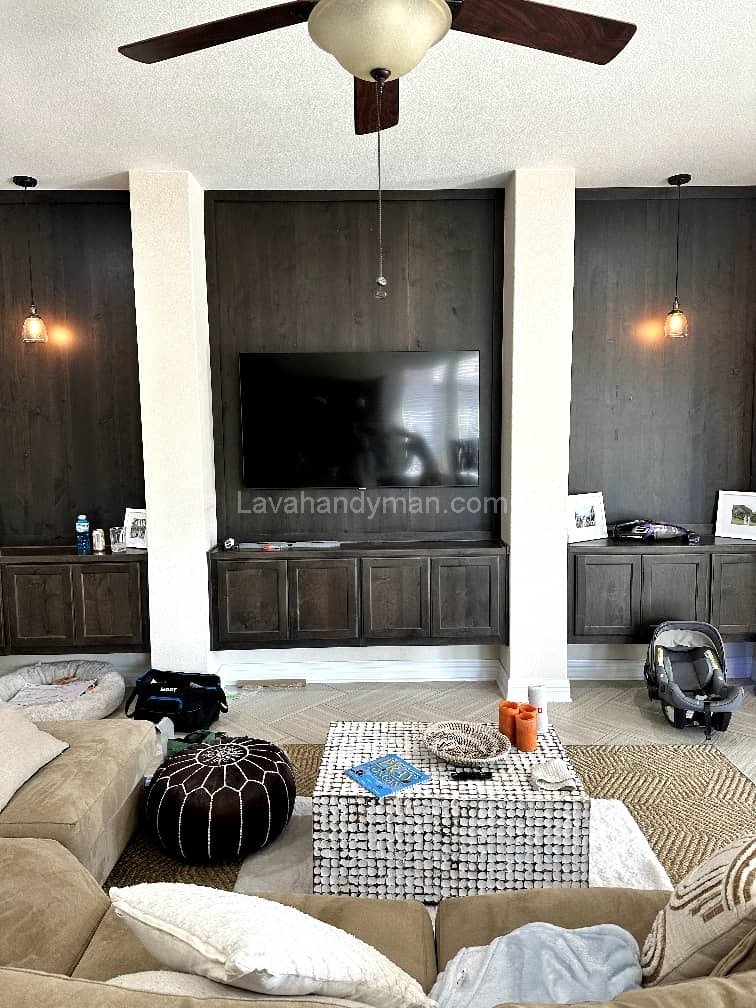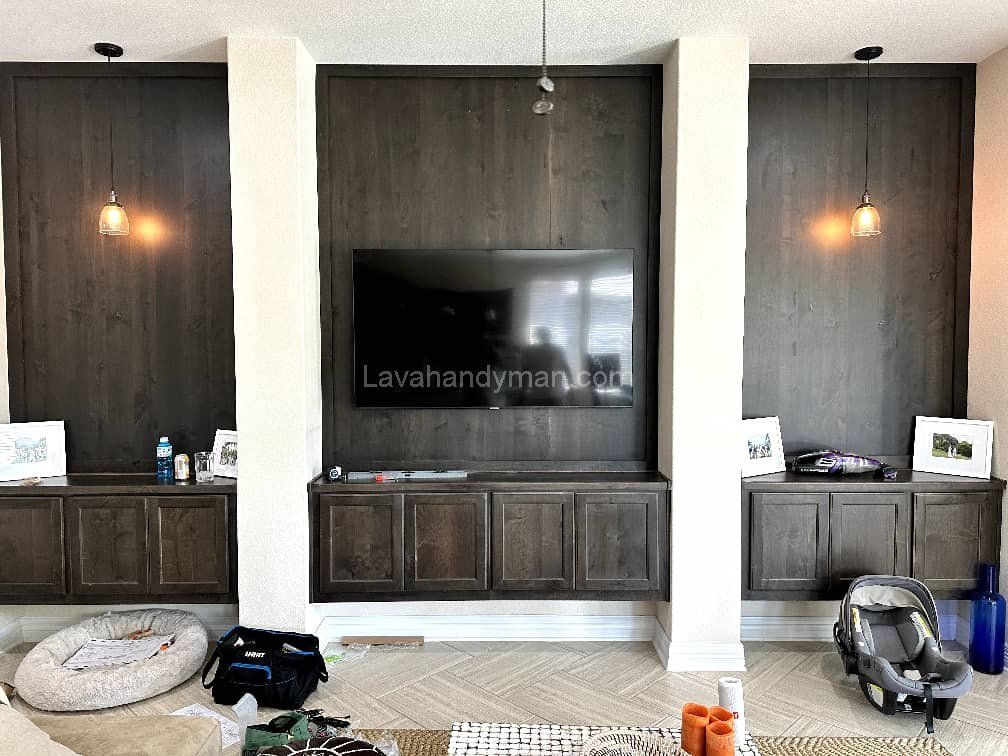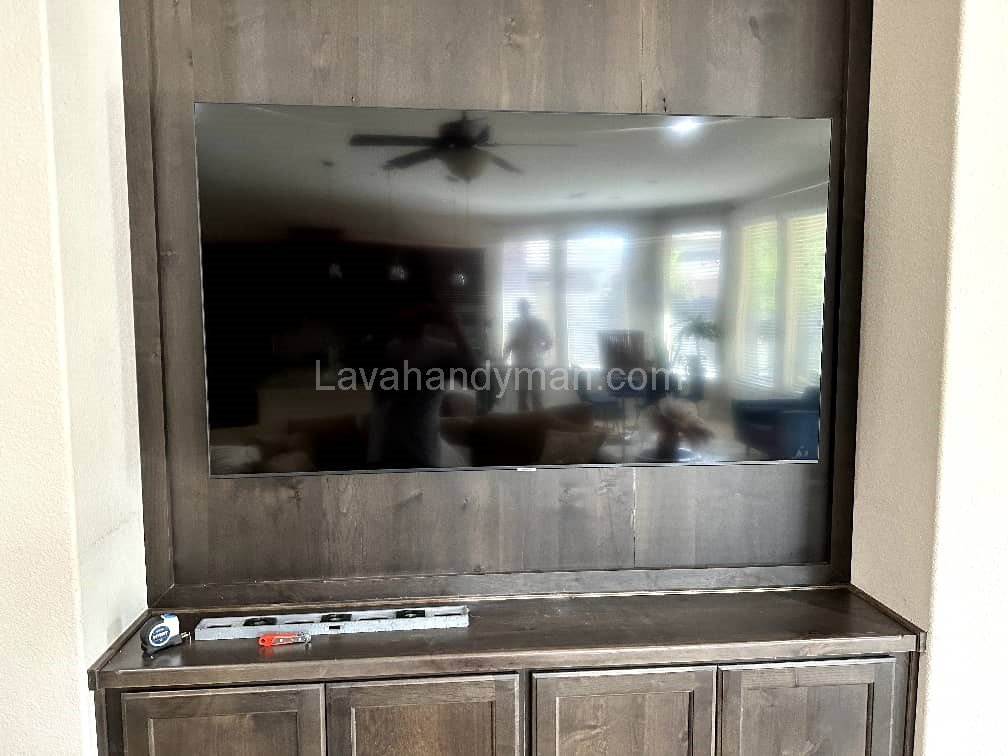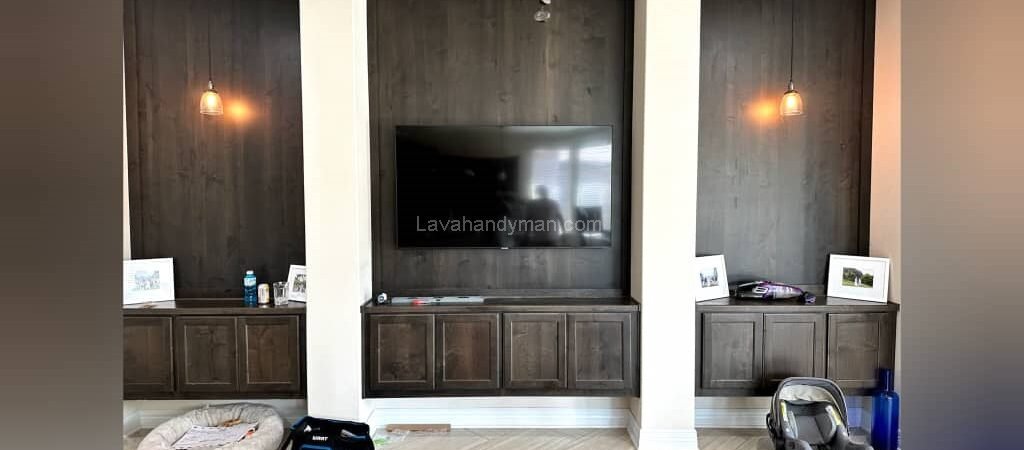Mounting a TV on an MDF Wall: A Complete and Practical Guide
Introduction
Today’s slim LED and LCD TVs have replaced the older, bulkier models. This evolution has made wall-mounting a popular choice — a method that not only saves floor space but also gives your living area a modern touch. However, when the wall is made of MDF (Medium Density Fiberboard), the process becomes more delicate. MDF, while attractive and smooth in appearance, has less strength compared to concrete or brick.
In this guide, you’ll learn step by step how to mount a TV on an MDF wall, what tools you need, what risks may arise, and how to ensure a safe and reliable installation.
Mounting a TV on an MDF Wall

Part 1: Understanding MDF
MDF (Medium Density Fiberboard) is a type of engineered wood, made by compressing wood fibers and resin under high pressure.
Advantages:
- Smooth surface suitable for paint or veneer
- Easy to cut and shape with woodworking tools
- Available in a wide variety of colors and patterns
- Lighter than brick or concrete walls
Disadvantages:
- Lower resistance to heavy loads
- Sensitive to moisture and water damage
- Requires special fasteners for holding heavy objects
Mounting a TV on an MDF Wall
Part 2: Why Mount a TV on MDF?
- A modern and stylish look for interiors
- Saves floor space by eliminating the TV stand
- Safer for children and pets
- Lets you choose the optimal viewing height
- Matches wall panels and interior designs seamlessly
Part 3: Possible Challenges with MDF
- Cracks or splits during drilling
- Screws loosening over time
- Risk of the TV falling if poor hardware is used
- Vibrations or noise when using a movable arm mount
Mounting a TV on an MDF Wall
Part 4: Tools and Hardware Required
Tools
- Electric drill with MDF-compatible drill bits
- Screwdriver (manual or electric)
- Measuring tape and pencil
- Spirit level to avoid tilted installation
- Rubber mallet
Hardware
- TV wall mount bracket (fixed or adjustable)
- Toggle bolts or metal anchors designed for MDF
- Metal washers to distribute screw pressure
- Reinforcement brackets or plates (if needed)
Mounting a TV on an MDF Wall
Part 5: Step-by-Step Installation Process
1. Choosing the Right Spot
- Ideal height: between 120–140 cm (47–55 in) from the floor.
- Avoid heat sources or damp environments.
- Ensure enough space behind the MDF for cable management.
2. Selecting the Right Bracket
- Fixed bracket: simple, strong, and cost-effective.
- Adjustable (swivel/arm) bracket: offers flexibility but puts more stress on MDF.
3. Marking and Drilling
- Mark the drill points accurately using a level.
- Drill carefully without applying too much force to avoid cracks.
4. Mounting the Bracket
- Use toggle bolts or expanding anchors that open inside MDF for better grip.
- Tighten screws securely but avoid over-tightening.
5. Attaching the TV
- Ideally, two people should lift and place the TV on the bracket.
- Check and lock the safety mechanism of the bracket.
6. Managing the Cables
- Use cable ducts for a tidy look or route wires behind the MDF panel.
Mounting a TV on an MDF Wall
Part 6: Safety Tips
- Avoid short or weak screws.
- Keep at least 5 cm (2 in) distance from MDF edges when drilling.
- Reinforce thin MDF walls with metal plates or wooden studs behind the bracket.
- Always install with assistance to prevent accidents.
Part 7: MDF vs. Concrete Wall Mounting
| Feature | MDF | Concrete |
|---|---|---|
| Aesthetics | High | Moderate |
| Strength | Lower | Higher |
| Drilling | Easy | Harder |
| Risk of Falling | Higher | Lower |
| Cable Management | Simple | More difficult |
Mounting a TV on an MDF Wall
Part 8: Strengthening MDF Walls
- Add a backing metal or wooden plate to spread load pressure.
- Locate wall studs or support frames inside the MDF structure.
- Choose high-quality brackets with dual safety locks.
- Add side brackets for extra stability if needed.
Part 9: Post-Installation Maintenance
- Check screws and brackets every six months.
- Re-tighten connections after adjusting TV angles.
- Clean MDF with a slightly damp cloth to prevent swelling.
Mounting a TV on an MDF Wall
Guide to Mounting a TV on an MDF Wall
Required Tools
- Standard TV wall mount bracket (matching weight & VESA size)
- Electric drill + MDF-compatible drill bits
- Screwdriver (manual or electric)
- Toggle bolts or MDF-specific anchors
- Metal washers to distribute screw pressure
- Measuring tape, pencil, and level
- An extra person to help lift the TV

Step-by-Step Installation
1. Choose the Right Spot
- Ideal height: center of the screen around 120–140 cm (47–55 in) from the floor.
- Avoid placing near fireplaces, heaters, or damp areas.
- Plan cable routes and check power outlets.
Mounting a TV on an MDF Wall
2. Mount the Bracket on the Wall
- Hold the bracket against the wall and level it.
- Mark the drill holes with a pencil.
- Drill slowly to avoid cracking the MDF.
- Insert toggle bolts or MDF anchors into the holes.
- Secure the bracket with screws and washers (do not overtighten).
3. Attach Bracket Arms to the TV
- Fix the movable arms/plates of the bracket to the TV’s VESA holes using the supplied screws.
- Use washers to protect the TV surface.
4. Hang the TV on the Bracket
- With assistance, lift the TV and hook it onto the wall bracket.
- Lock the safety mechanism to keep the TV stable.
5. Manage the Cables
- Route cables through ducts or hide them behind the MDF panel.
- Avoid tension or bending on the cables.
Mounting a TV on an MDF Wall
Important Safety Tips
Inspect and tighten screws every 6 months.
Never use short or weak screws.
Keep drill holes at least 5 cm (2 in) away from MDF edges.
For heavy TVs, reinforce the MDF with a back plate or secure directly to wall studs behind it.
Choosing the Right TV Bracket for MDF Walls
1. Fixed Wall Mount
- Simple, affordable, and very sturdy
- Puts minimal pressure on the MDF
- Best choice for MDF walls
Mounting a TV on an MDF Wall
2. Tilting Wall Mount
- Allows vertical angle adjustment (up/down)
- Slightly more pressure on the MDF than fixed mounts
- Suitable when the TV is mounted higher than eye level
3. Full-Motion / Articulating Wall Mount
- Can move forward, backward, and sideways
- Exerts the most lateral pressure on MDF
- Only recommended if the MDF wall is reinforced with wood or metal studs
4. Ceiling Mount
- Used for specific applications (cafés, gyms, special spaces)
- More complicated to install
- Not recommended for MDF unless the ceiling/backing is reinforced
Mounting a TV on an MDF Wall
Key Tips When Choosing a Bracket for MDF
Safety lock: Bracket should have a mechanical lock or latch to prevent slipping
Safest options: Fixed or tilting mounts
Weight capacity: Bracket should support 20–30% more than the TV’s weight
VESA compatibility: Ensure the bracket matches the TV’s mounting holes
Quality: Choose steel brackets with a wide backplate to distribute pressure evenly
Mounting a TV on an MDF Wall
Comparison of TV Wall Mount Brackets for MDF: Installation Time & Requirements
| Bracket Type | Approx. Installation Time | Complexity | MDF Reinforcement Needed | Lateral Pressure Risk | Main Use |
|---|---|---|---|---|---|
| Fixed | 30–45 minutes | Low | Low | Low | Most MDF walls; simple and safe |
| Tilting | 45–60 minutes | Medium | Medium | Medium | When vertical angle adjustment is needed; moderately strong wall |
| Full-Motion / Articulating | 60–90 minutes | High | High | High | Only reinforced MDF with wood/metal studs |
| Ceiling Mount | 90–120 minutes | Very High | Very High | Medium | Special spaces; reinforced wall or ceiling required |
Mounting a TV on an MDF Wall
Key Notes:
Full-motion and ceiling mounts pose high risk of damage or TV falling if MDF is not properly reinforced.
Times include preparation, marking, drilling, bracket installation, and hanging the TV.
Brackets with more movement require longer installation and are more complex.
Optimal TV Height for MDF Wall Mounting
1. Standard Viewing Height
- The center of the TV should be roughly at eye level when seated.
- Typically, 120–140 cm (47–55 in) from the floor is ideal.
- Mounting too high or too low can cause neck and eye strain.
2. Relation to Viewing Distance
- For 45–55 inch TVs: viewing distance should be about 1.5–2.5 meters (5–8 ft).
- If the distance is greater or shorter, adjust the TV center slightly up or down for a comfortable viewing angle.
3. Tips for Mounting on MDF
- Mark the center height before drilling.
- Use a level to ensure the TV is perfectly straight.
- For large or heavy TVs, ensure the bracket and MDF can handle the load.
4. Mounting in Bedrooms or Special Spaces
- In bedrooms, the height can be slightly higher since TVs are usually viewed from the bed.
- In large rooms or public areas, height should allow everyone to have a clear viewing angle.
5. Additional Tips
- If mounting above standard height, use a tilting or full-motion bracket.
- Avoid placing the TV too low to reduce neck strain.
- TV size and viewing distance are the main factors for determining height.
✅ Summary:
For large TVs or higher mounts, a tilting or adjustable bracket is recommended.
TV center = eye level of seated viewer (~120–140 cm / 47–55 in).
Consider viewing distance and TV size.
Conclusion
Mounting a TV on an MDF wall is absolutely possible and visually appealing, but only if done with care. The key factors for success are:
- Using a strong, standard wall mount
- Installing with proper MDF-compatible anchors
- Keeping a safe distance from edges
- Performing regular check-ups on the installation
By following these guidelines, you can safely enjoy a wall-mounted TV while giving your space a modern, uncluttered look.
📞 Need Help?
Let us take care of the hard work while you sit back and relax.
📍 Serving: Austin, Round Rock, Cedar Park & more
📱 Call or Text: (737) 420-6992
🌐 Visit: https://lavahandyman.com


